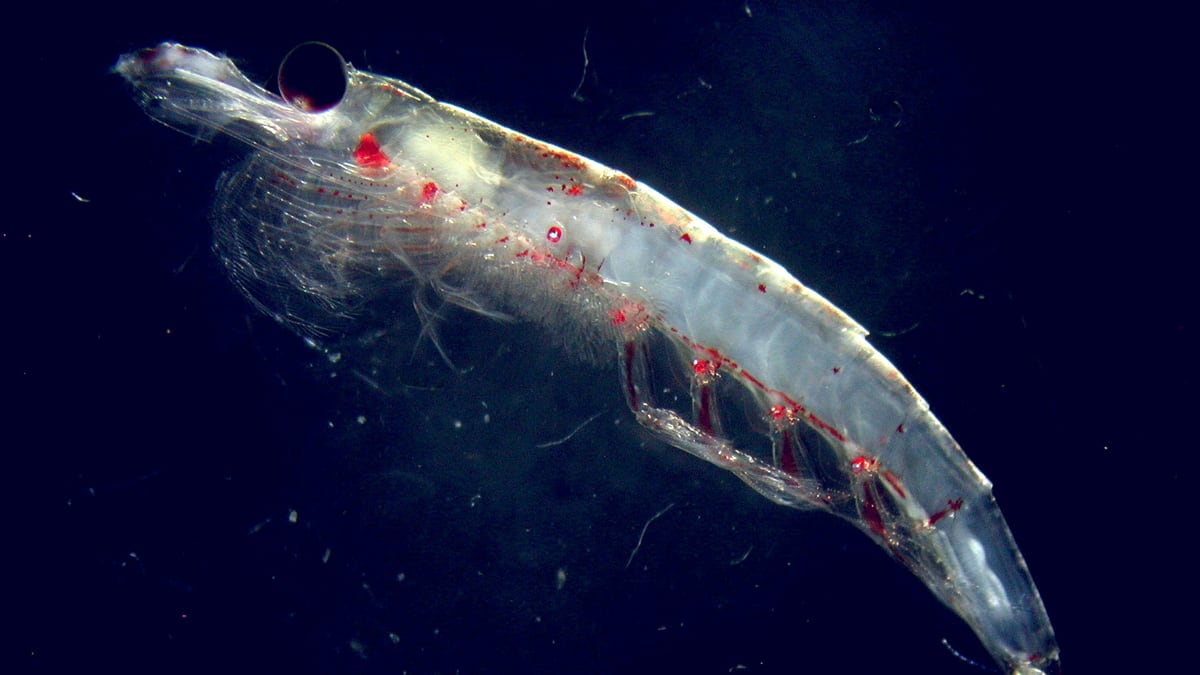Last month, the U.N. issued an alarming report predicting worldwide starvation by the year 2050 if we don’t drastically change how and what we eat. A growing number of activists, environmentalists, and even chefs think they have a solution: eating farther down the food chain. And what’s at the very bottom, at least in the ocean? Krill.
These toothpick-sized, shrimplike crustaceans thrive in vast quantities in Antarctic waters. A single blue whale eats four to eight tons of krill every day, and ocean-dwelling creatures together devour over 150 million tons per year. Their schools stretch for miles in the Southern Sea, packing up to 30,000 creatures per cubic yard. And some hunger experts point out that, given these huge numbers and krill’s short lifespan, they’re an endlessly renewable protein source.
Krill have long been eaten in Russia, Korea, and Japan as crunchy dried snacks, pizza toppings, and a concentrated paste mixed into soups, salads, and other dishes. They’re also a common ingredient in supplements and pet foods, but they’re foreign to most American diners—with the exception, perhaps, of those who’ve seen Happy Feet Two. The film features a pair of lively Antarctic krill among its main characters. In one scene, Will the Krill, voiced by Brad Pitt, wants to become a carnivore (krill eat only algae), but his pal Bill the Krill, voiced by Matt Damon, calls foul. “Where are you going?” Bill asks as Will swims off. “I’m movin’ up the food chain,” Will declares. And well he might.
As fears rise about future food shortages, more companies worldwide are harvesting and selling krill—while, at the same time, “bottom-of-the-food-chain cuisine” is becoming as hip as it is sensible. These efforts are boosted by serious research into the crustaceans’ nutritive value. One study affiliated with West Virginia University found that krill “is a rich source of high-quality protein, with the advantage over other animal proteins of being low in fat and a rich source of omega-3 fatty acids.” These benefits, along with sky-high antioxidant levels, have earned krill the nickname the “magicians” of the ocean. Meanwhile, the U.N.’s Food and Agriculture Organization notes that as other food resources shrink, “there will be greater emphasis on harvesting species such as krill” and that “developments in food technology may result in more rapid cost-effective forms of krill for human consumption.”

One restaurant is taking the lead in bringing krill to American cuisine. Eon Coffee in Hayward, California—which claims to be the nation’s only eatery with krill on its menu—serves it in entrées and even sweets. “Other restaurants don’t serve krill, but they should because it’s very healthy,” Martin Schlaepfer, Eon’s manager, told The Daily Beast. Schlaepfer mixes krill with red onions, lettuce, and crab in the Spicy Omega-3 Crab Wrap; with tomatoes, capers, tuna, and walnuts in the Omega-3 Tuna Salad; and with tuna, cheddar and dill sauce in the Omega-3 Panini. You can’t really taste the krill in his chewy krill-oatmeal-raisin cookies, but they’re surprisingly satisfying.
Schlaepfer first began incorporating krill into his menu seven years ago, when a salesman from the company that provided Eon’s seafood offered him a block of peeled frozen krill. “I knew how rich it was in omega-3s. I thought: Why not? It’s just like a tiny shrimp, but without much flavor,” he said. “We sell lots of krill sandwiches every day…We only realized recently how unique this is.”
Over 40 percent of the krill caught by Japanese fisheries is now used as food. And the Canadian company that sells Schlaepfer his krill has recipes on its website for krill eggrolls, krill dumplings, and krill cannelloni, but Eon is its only customer that actually serves krill as food.
Despite krill’s potential benefits, hunger experts also see major obstacles for relying on it as a significant human food source. Eating krill “makes sense nutritionally,” said Marie-Sophie Whitney, senior nutrition adviser at the humanitarian group Action Against Hunger. “There is indeed a need to look for food that would be less costly from the energetic point of view, and that is easy to grow and abundant.”
And yet, “the idea of krill does not make much sense for the biologist inside me,” she said, not only because of the potential dangers posed by overfishing, but also because “the people who are the most vulnerable nutritionally are also the ones who have the hardest time accepting new foods.”
Indeed, while there’s plenty of krill out there, part of the reason it exists in such large quantities is to fuel the Antarctic ecosystem. And tapping into that supply could have major repercussions.
“Krill can’t be farmed,” said Susan Lieberman, director of international policy for the Pew Environmental Group, which oversees the Antarctic Krill Conservation Project. Krill can only be harvested wild, as it has been since the 1960s, albeit almost entirely for the supplement, pet-food and livestock-feed markets. And while we catch only a fraction of the 5-million ton limit set by the Commmission for the Conservation of Antarctic Marine Living Resources (CCAMLR) every year, Lieberman still advises serious caution.
“We might not run out of krill. It’s not an endangered species. But it’s the basic foundation of the Antarctic food chain. Overfishing would devastate not only the krill, but the whole ecosystem that depends on krill,” she said. “We need to make sure there’s a catch limit, and that this limit is conservative. We have to make sure that there are observers on the boats and that everything is done sustainably.”
Since industrial krill fishing began 50 y years ago, the difficulty of working in the Antarctic has always kept those numbers low, according to Lieberman. But new trawling technologies developed in Norway are poised to multiply the annual krill harvest exponentially.
“Yes, it’s wiser and ecologically more sustainable to eat lower on the food chain,” she said. “Eating crustaceans is more sustainable than eating the larger animals that eat crustaceans. But we have to make sure we’re not competing for krill with their natural predators. We have to make sure that when and if you take an omega-3 supplement or eat a krill sandwich, you’re not taking food out of the mouth of a penguin or a whale.”




